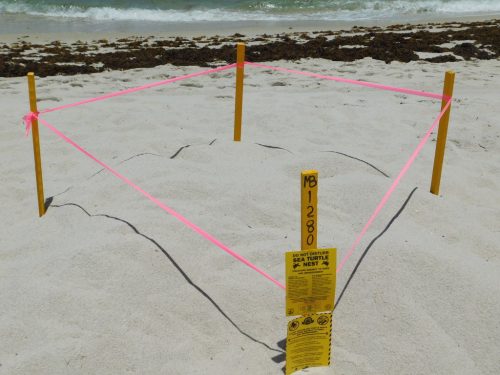What is going on?
For most of the year, Florida’s beaches serve as nesting grounds for several species of sea turtles. Adult female turtles will make the return to their own nesting grounds to lay the next generation of sea turtles. After spending all her youth traversing, she will finally come ashore for the first time in years. Although Florida’s beaches are used as nesting grounds throughout the year, the peak months are May through July and is the best chance for you to witness this ancient ritual!
Under the cover of darkness, females crawl ashore, dig nests using their hind flippers, and deposit anywhere from 80-120 eggs per nest. After covering the nest with sand, in an attempt to both protect the eggs from predators and to provide a home, the mother will return to the ocean, leaving the eggs to incubate for 45 to 70 days.
Sea Turtle Nesting Behaviors
During this epic migration and breeding adventure, sea turtles exhibit some of the most fascinating behaviors in the animal kingdom. One of the most impressive phenomena is nest fidelity; a deep-rooted instinct that drives female sea turtles back to the very beach where they themselves hatched to lay the next generation of eggs. Imagine crossing thousands of miles across an open ocean and then finding your way back to where your life began without visible landmarks. It is likely that this homing ability is guided by a combination of cues, including the Earth’s magnetic field, which is likely imprinted as a hatchling, and used as an internal GPS encoded from birth.
 Equally remarkable is how these nesting rituals unfold. Under the cover of the night sky, a female sea turtle will crawl onto the beach, to avoid most predators and reduce exposure to the hot sun. While moving slowly and deliberately, they come ashore using their strong flippers, dig a cavity with their hind flippers, and lay around 80-120 eggs in a single nest. Oftentimes, they don’t stop at a singular nest. A female can lay 4-7 nests in a singular season, spaced apart by two-week intervals. This reproductive strategy boosts the chances that at least some of her offspring will survive, especially given the many dangers hatchlings face.
Equally remarkable is how these nesting rituals unfold. Under the cover of the night sky, a female sea turtle will crawl onto the beach, to avoid most predators and reduce exposure to the hot sun. While moving slowly and deliberately, they come ashore using their strong flippers, dig a cavity with their hind flippers, and lay around 80-120 eggs in a single nest. Oftentimes, they don’t stop at a singular nest. A female can lay 4-7 nests in a singular season, spaced apart by two-week intervals. This reproductive strategy boosts the chances that at least some of her offspring will survive, especially given the many dangers hatchlings face.
 Another layer of protection comes from false crawls. False crawls occur when they spot too many predators or are scared by the presence of humans, thus she comes ashore but quickly returns to the ocean to lay her eggs later or at a different location. While laying eggs, the mother flings sand across a wide area which confuses predators like raccoons and ghost crabs.
Another layer of protection comes from false crawls. False crawls occur when they spot too many predators or are scared by the presence of humans, thus she comes ashore but quickly returns to the ocean to lay her eggs later or at a different location. While laying eggs, the mother flings sand across a wide area which confuses predators like raccoons and ghost crabs.
While the nest is hidden away in the sand, a mind-blowing biological feature of sea turtles takes place; temperature-dependent sex determination. During the incubation process, the temperature of the sand determines the sex of the hatchlings. With warmer sands, there will be more females, while with cooler sands, more males are produced – a saying some people use is “hot chicks, cool dudes.” What this means is that as temperatures continue to rise, sex ratios are going to be more heavily skewed towards female sea turtles.
Sea turtles are an amazing story of navigation, timing, stealth, and instinct, and it is built off an ancient rhythm older than trees. Witnessing a nesting turtle is more than a moment in nature; it is a glimpse into a biological legacy millions of years in the making.
What you can do!
Sea turtle hatching is a stressful time for both the mother and the offspring. There are a few ways you can help to reduce this stress and navigate a system that has become endangered.
The easiest ways to help are to stay off dunes, flatten sandcastles, fill in holes, and turn off lights near and on beaches. But this extends further, by simply following the leave the no trace concept and by not disturbing nesting turtles, you can help sea turtle populations begin to slowly recover. Of course, it’s not nearly as simple as that, but the collective action of these simple steps is a powerful tool in sea turtle conservation!
Sea turtle nesting is a powerful reminder of how deeply interconnected our natural world is. Small changes in our behavior can make a big difference in helping these ancient marine creatures thrive.
Information from FAU, FWC, Sea Turtle Conservancy, UF IFAS, and National Marine Life Center. Cover image by Angi1010 on iNaturalist (CC BY-NC), fence nest by David Garza (CC BY), and tracks by Anthony Brais (CC BY-NC).